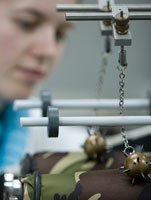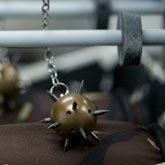Quality Controlled
The Consumer Product Safety Reauthorization Act makes Intertek's services more vital then ever.
When a series of recalls involving Chinese-made toys containing lead made headlines last year, who would have guessed that the result would be tougher standards for every kind of apparel, from designer jeans to highend suits.
The Consumer Product Safety Reauthorization Act, which President Bush signed in August and parts of which take effect immediately, will bring big changes to the apparel industry, according to Gene Rider, vice president of consumer goods for North America at Intertek.
Established in 1885 to help customers assess their products and commodities against a wide range of safety, regulatory, quality and performance standards, London-based Intertek claims it is the leading international provider of quality and safety services to a wide range of global and local industries. The company, which opened its first textile lab in 1973 in China, has more than 23,000 employees and more than 1,000 offices and laboratories in 110 countries. Clients include a who’s who of apparel companies. “There aren’t many well-known brands we don’t work for,” Rider says.
The California Apparel News spoke with Rider about the new safety act, what apparel companies should expect, and how using Intertek is better and less expensive than doing quality assurance in-house.
CAN: What services do you offer for the apparel and textile industries?GR: We offer the complete service of providing a robust quality and safety process for folks who manufacture and or import apparel. The service helps them understand that their vendors and factories are in compliance with their values and brand image. We ensure they get a consistent-quality product.
We provide mill programs where we evaluate fabric, which is really important because a lot of the defects that occur in apparel are the result of defects in fabric, not the workmanship. If you can identify and solve problems with particular fabrics, you can save a lot of trouble in terms of customer returns.
CAN: Why do apparel companies need a third party like you? Why can’t they work out these issues directly with their suppliers?GR: The main reason is that we have the equipment and staff in the countries where products are being manufactured, and our customers tend not to have the laboratory equipment. Also, it’s not what they do best. They’re folks who are very good at fashion, but when it comes down to quality and safety, they don’t need that expertise because they can outsource it to us.
I think you’d be stunned by how many different parameters there are for measuring the quality of garments. There’s the question of spirality, or whether a garment twists on you after washing. There’s colors coming out in the wash, and what we call “crocking,” or how a fabric wears when rubbed against itself, and whether it wears out too quickly so someone will think it was an inexpensive item. There are hundreds and hundreds of tests done to ensure that a garment is high-quality. An item of apparel is a very technical product.
CAN: I can understand a designer not being an expert in quality control, but shouldn’t their subcontractors be?GR: The fact is, it doesn’t work that way. Factories tend not to be on top of it to the extent you need. And certainly now with the Consumer Product Safety Reauthorization Act, it’s impossible because there’s a requirement that there be some sort of laboratory test to comply with the laws regarding apparel.
You’re looking for vendors who will give you the fastest turnaround and best price, and those things are a little conflicting with [getting] the highest quality you may be looking for.
CAN: China has become the go-to country for outsourcing. Are there any special issues in regards to China?GR: There’s nothing special about dealing with China. Any manufacturer who has a robust quality and safety process will get very high-quality products out of China.
CAN: What about issues like child labor and environmental concerns?GR: They’re Eastern, not Western, so our expectations are different from theirs. A lot of what we do is communicate expectations. You can build a core of suppliers who share your values in regards to child labor, safe work conditions and wages, but it takes years for your suppliers to understand what you’re saying. Companies like us work to make sure the message is clear, that it’s not just words but people are actually going in and checking. It’s the old adage, “Trust, but verify.”
CAN: Tell us about the Consumer Product Safety Reauthorization Act.GR: It’s the first time in 20 years there has been a major overhaul of the CPA. It was only signed into law by President Bush in August, so the interpretation still has to happen, but one thing the act now requires is that importers have evidence that their products meet its requirements. Before, you just brought products out and hoped nobody was looking. So now you have to have a test done by a certified laboratory.
The next thing is an increase in fines. The maximum has gone from just under $2 million to $15 million for illegally bringing in unsafe product. This is a huge deal. A company can no longer risk dealing with a fine.
CAN: Will companies need you more than ever?GR: They won’t exactly need us more, as the majority of brands do a fine job. But it’s going to be more visible now. They’re going to have to be able to associate a product in a container with a report, so it’s more arduous as far as testing and managing data to make the proofs you need to get the product through customs.
I think the apparel industry will find that there are many restrictions they previously didn’t have to deal with or [that they previously did not have] to have such a high level of documentation. So those are going to be big changes for the industry.
We’re expanding our textile laboratories in North America to accommodate the increased requirements. We’re going to have a new laboratory early next year in the Chicago area.
CAN: When does the act become effective?GR: Part of it is effective this year. It’s up to the Consumer Project Safety Commission; they have a long list going out through next year, but some things are happening right now.
CAN: What was the motivation behind it?GR: 2007 became the year of the recall. But once the government got its teeth in it, the number of recalls is probably higher in fiscal year 2008 than in 2007.
The other thing is Congress latched onto this and said: “We want safe products. We’ve been sitting here thinking all products imported into the U.S. are safe.” And now we’re finding out that’s not the case.
CAN: What are the safety issues when it comes to clothing?GR: It starts with flammability. The Consumer Protection Act is especially rigid for children’s sleepwear. Then it goes to things like lead and small parts that children can choke on, drawstrings on hoods, and it goes on and on. Most of the safety issues are about children because they’re a huge percentage of the population.
CAN: What about for adult clothes?GR: Flammability is the issue.
CAN: But clothing is combustible; it’s going to burn if you set fire to it. It’s not like a television that might suddenly explode and set one’s house on fire.GR: It’s not that clothing has to resist flames; it’s how fast the fire propagates. There’s a standard for flame spread—I think the test is 30 or 40 years old—and the standard determines whether the flame spread is so fast that the person wearing the garment won’t have reasonable time to react.
CAN: How big does an apparel company have to be before they need your services?GR: It’s not a question of size. It’s the fact that we can deliver these services cheaper than they can do themselves. Even if you make five garments, you’re still liable for them to meet legal requirements. The government doesn’t say, “You’re a small manufacturer, so we’re not going to fine you.”
CAN: How do you charge for your services?GR: Tests generally run $25 to $100.
CAN: Must each item in a collection be tested?GR: Each fabric, not each item.
CAN: What kinds of environmental issues are you seeing these days?GR: Eco comes down to two concepts. The first is how eco-friendly the product is. The second is how eco-friendly the manufacturing is. Think of it as the carbon footprint. You have to be careful because sometimes products that can be disposed of and not cause environmental damage were not made in an eco-friendly way. So it has a lot to do with a company’s brand image and what they’re trying to say to their customers and not getting caught in this trap.
You saw it with making ethanol out of corn. We finally realized that it doesn’t emit as much carbon dioxide as gasoline, but boy does it give off a lot making it.


























